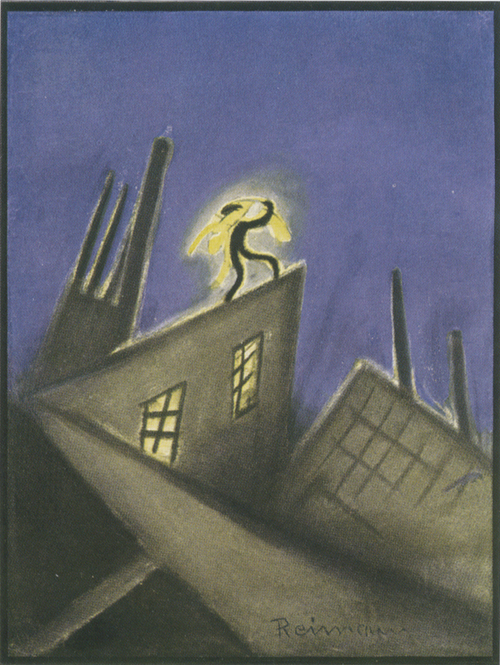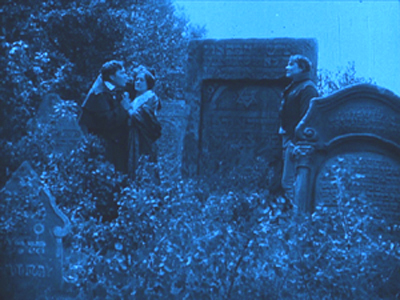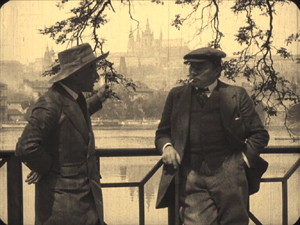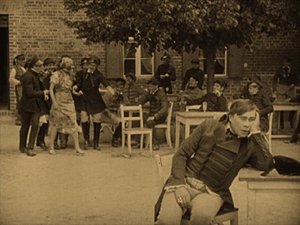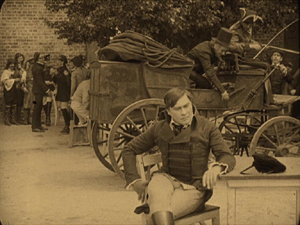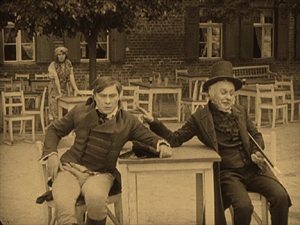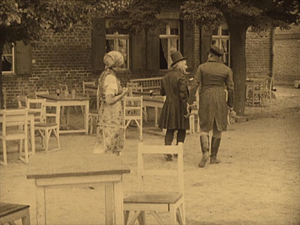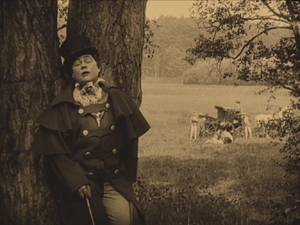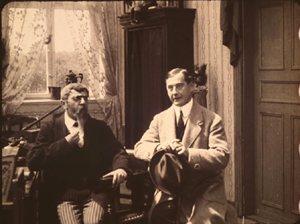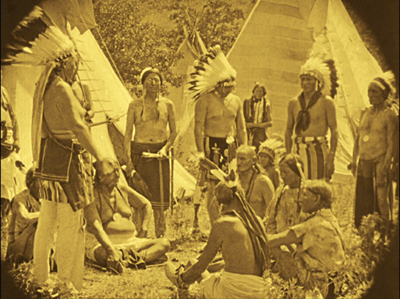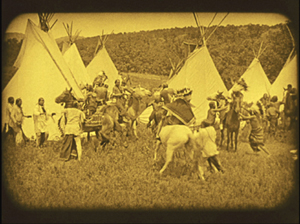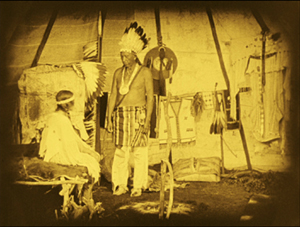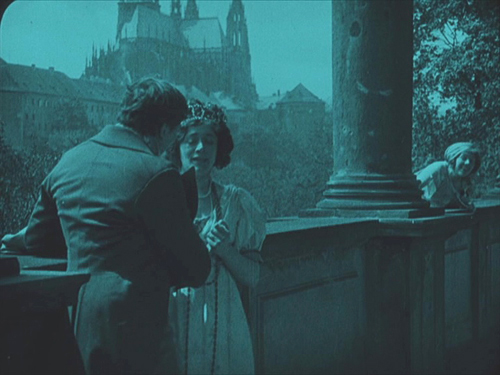Silents nights: Stocking-stuffers for those long winter evenings, the sequel
Sunday | November 20, 2016 open printable version
open printable version
Kristin here:
A welcome translation, long awaited
From 1991 to 2003, the University of Wisconsin Press published an even dozen books of cinema history in the series Wisconsin Studies in Film. The editorial board consisted of David Bordwell, Donald Crafton, and Vance Kepley, with me as supervising editor. In a little over a decade, we accomplished our simple goal of fostering excellent historical studies in an era when it was far less easy to get such books published than it is now.
Among the dozen was Film Essays and Criticism, a volume of previously untranslated reviews and essays by Rudolf Arnheim (1997). That volume was made possible by the dedication of Brenda Benthien, its translator. Now Brenda has pursued a project she and I discussed long ago. She has brought to fruition a translation of the important classic book, Rudolf Kurtz’s 1926 Expressionismus und Film.
Kurtz’s book has been important enough to warrant two reprint editions in German, one in 1965 by Verlag Hans Rohr, with the illustrations all in black and white and the original cover painting by Paul Leni not used, and another in 2007 by Taschen, edited and with a lengthy essay by Christian Kiening and Ulrich Johannes Beil, as well as the original color illustrations and cover. The English translation, published earlier this year by John Libbey, essentially replicates the 2007 edition, including the cover design and the Kiening/Beil essay. The color illustrations, such as the frontispiece, a design by Walter Reimann for Das Cabinet des Dr. Caligari (top), are also reproduced.
Kiening and Beil are listed as editors here as well. As they point out in their brief introduction to the English edition, there had already been translations into French and Italian, but without the illustrations. Our English version may be late, but it comes much closer to replicating Kurtz’s original.
Kurtz’s title sums up his approach. He defines Expressionism in relation to the other arts of the era, particularly painting and theatre, and discusses the style of six films. Of these, The Cabinet of Dr. Caligari and Waxworks are familiar; From Morn to Midnight, Genuine, and Raskolnikow less so; and The House on the Moon is still, as far as I know, completely lost. (An excellent DVD of Von Morgens bis Mitternacht is available from the FilmMuseum via the link. The Alpha editions of Genuine and Raskonikow are, by report, American cut-down versions with poor visuals.)
One benefit of consulting the original or Benthien’s translation is to reveal that Siegfried Kracauer distorted the famous quotation from designer Hermann Warm that he includes in From Caligari to Hitler: “Films must be drawings brought to life” (p. 68). The original, “Das Filmbild muss Graphik werden” (p. 66 of Expressionismus und Film) is more accurately rendered by Benthien as “The filmed image must become graphic art” (p. 68). “Graphic art,” after all, includes far more than drawings.
The Kiening and Beil essay mentioned above is included in the translation. It is a substantial piece, taking up 75 pages of the book’s total of 214. The authors explain Kurtz’s background in the art world and film industry of the era, as well as discussing conceptions of Expressionism in the years leading up to the release of Caligari. They cite many contemporary theorists’ and critics’s views of of Expressionism in the cinema. Kiening and Beil flesh out Kurtz’s work by pointing out several Expressionist or semi-Expressionist films that Kurtz doesn’t mention. They explain how From Caligari to Hitler and (slightly later) Lotte Eisner’s The Haunted Screen became popular as explications of Expressionist cinema, leaving Kurtz in relative obscurity until recent decades. In short, the essay, entitled simply “Afterword,” is an erudite and invaluable addition to this edition of Kurtz’s book.
Cinematic after all
Way back in 1969, when I was taking my first film class, I saw The Cabinet of Dr. Caligari and became fascinated with German silent cinema, especially the Expressionist movement. I still retain a surprising willingness to sit through German films of the era–even mediocre ones–with their slow pace and heavy acting. Back in those early days, I tried to see the German classics, many of which were available in poor 8mm and 16mm copies.
I vaguely remember being disappointed by my first viewing of The Student of Prague. At the time of that viewing, film studies were still in their early days, and just about everyone assumed that a film was “cinematic” if it had quite a bit of editing and camera movement. The Student of Prague, like many films of its era, was short on both. Its long-take opening shot, with no cut-ins or tracking camera, seemed the epitome of stagy cinema.
I don’t know which version of the film I saw, but it wasn’t the original 1913 one. The film has a complicated history of re-editing and re-release, both theatrically and for home video. This history is recounted in the booklet accompanying the Munich Filmmuseum’s new DVD release of a reconstructed version approximating the 1913 release print, as well as the much shorter American release print. The original version was sold to a producer, Robert Glombeck, who exploited the occasion of the 1926 remake to release the original, highly reworked, including the addition of 107 intertitles. (The original had deliberately been made using a minimal number of intertitles.) Although shortened American and Japanese release prints of the 1913 version survived, the original German one did not.
The new reconstruction has been made from the Glombeck negative, as well as the other release prints, a script, and the incomplete censor’s record. While it cannot claim to be an exact replica of the original, it is far closer than we have had up to now. The excessive intertitles have been removed and a prologue shot showing scriptwriter Hanns Heinz Ewers and lead actor Paul Wegener looking up at Prague Castle restored. (It survived only in the American print.)
Even before this new release, I had gained a far greater respect for this supposedly uncinematic film. My first viewing came before academic interest in early film blossomed with events like The Brighton Project in 1978, trends like the spread of film archives and the rediscovery of many lost prints, and a general recognition of the historical, entertainment, and aesthetic value of early films, even among the general public. Gradually historians had realized that editing and camera movement were not the only techniques that exploited the techniques of the medium. There were long takes and intricate staging. There was the compositional exploitation of depth and the surprises of offscreen space. During the period 1992 to 1998, Yuri Tsivian, Lea Jacobs and Ben Brewster, David, and I explored various techniques that cinema of the 1910s used for expressive purposes. (See the codicil for citations.)
In 1993 I gave a keynote address at the fifteenth IAMHIST conference, “The International Exploration of Cinematic Expressivity, 1913-1919,” at the University of Amsterdam. In it I discussed a wide range techniques of framing, staging, acting, and unusual editing that were innovated in films made in many countries, all tending to enhance expressivity. Among my examples was that opening scene of The Student of Prague. I said, “This seems to me a case that could be dismissed as primitive. Yet it could also be described as a complexly staged scene that sets up the basic narrative situation and uses depth and unexpected appearances from off-screen to heighten the impact of the action.”
Now that we have something approximating the original version, we can look again at that first shot. There are two presentations of the reconstruction in this set, one with a piano rendition of the original score, which survives only in a printed piano score, and one with an orchestration of that score. The piano version runs distinctly shorter, and it looks to be projected at about the right rate. In this presentation, the first shot runs 3 minutes 40 seconds. It contains only two intertitles. After an establishing shot of a beer-garden, our hero enters, and the students hail him as the best fencer among them. This is information that we could only learn through speech. The title also provides his name, Balduin.
He sits glumly, largely ignoring the action behind him as Lydushka (apparently secretly in love with Balduin) enters and the students lift her onto a table for a dance. As this ends, a coach suddenly drives in from the left, and as it blocks most of the background, the students swiftly exit.
Scapinelli gets out of the coach and joins Balduin, tapping him slyly on the shoulder as Lydushka watches, growing anxious as the two start a conversation. The second intertitle provides crucial plot information, as Balduin announces that he is ruined and needs either a winning lottery ticket or a rich heiress. Scapinelli leads him out, the camera reframing slightly with them and with Lydusha, who moves forward to watch them. Soon Scapinelli will appear in Balduin’s room and make the fateful bargain, providing riches and the heiress in exchange for his mirror image.
There is nothing quite like this shot in the rest of the film, but there are some very impressive depth shots. These typically involve a character in the foreground or background looking at other characters. Such shots substitute for eyeline-match cutting, which was not yet a convention of German cinema. In the shot at the bottom of this entry, Lydushka spies on a romantic scene between Balduin and Countess Margit. Below, Balduin realizes that his Doppelganger has killed Margit’s fiancé in a duel, thereby disgracing him.
And there are, of course, the extraordinary shots of Balduin together with his Doppelgänger , achieved by the great German cinematographer, Guido Seeber. When the double, on the right, confronts the lovers in the old Jewish cemetery, the careful staging and double exposure allow Balduin to cross behind the large tombstone and enter the space where his nemesis has been moments before (see the top of this section).
Apart from the different versions of The Student of Prague, the DVD set contains a 1913 short, Die ideale Gattin (“The Ideal Wife”), also “made by” Hanns Heinz Ewers. (The edition treats Ewers as the main creator of The Student of Prague, though most sources credit Stellan Rye as the director. It is true that at the time the scriptwriter was considered the creator of a film, but there’s no clarification of this in the notes.)
This is a charming little comedy starring Paul Biensfeldt as the hero oppressed by his strict, humorless female relatives and in search of a perpetually-smiling wife. Biensfeldt is a familiar face if not name, having played roles in several of Lubitsch’s German features, such as Menon in Das Weib des Pharao. Lubitsch himself plays a small role here, appearing as the matchmaker in only one scene. He is unrecognizable under a wig and beard and has nothing little to do.
The DVDs can be ordered directly from the Edition Filmmuseum shop. I note that Filmmuseum editions are now being sold on Amazon.de as well.
No buffalo were harmed in the making of this film
In March we praised the rescue of a major documentary, Strange Victory, released by Amy Heller and Dennis Doros’ Milestone Film & Video. The company has since brought out a film long thought to be lost, The Daughter of Dawn, one of a handful of fiction features from the decade that used casts entirely made up of Native Americans. (Notable others are Hiawatha [1913], In the Land of the Headhunters [1914], The Vanishing Race [1917], and Before the White Man Came [1920].)
As often happens in such cases, the director of The Daughter of Dawn, Norbert A. Myles, was a white man. He had started as an actor in 1913, directed three features in the 1920s, and went on to a long career working as a makeup artist (usually uncredited) on many of the most famous films of the 1930s and 1940s–most notably Ray Bolger’s makeup as the Scarecrow in The Wizard of Oz.
And as also often happens, the scenario avoids analyzing the culture of the ethnic group in question. The film largely falls back on a very conventional central premise. The film centers around a love rectangle, with the heroine, a Kiowa chief’s daughter nicknamed Daughter of Dawn, in love with the stalwart hunter White Eagle. Black Wolf, a rich brave seeking to become the new chief, spurns the devoted Red Wing and seeks permission to marry Daughter of the Dawn.
There are some action scenes, notably a chase after a herd of buffalo early on. We don’t see any actual killing of buffalo, and although the hunters return to their village announcing success, there is no glimpse of carcasses. Whether this was due to budgetary factors or legal or safety restrictions is unclear. A later battle scene between the Kiowas and some raiding Comanches is more successful. Myles wisely keeps his camera at a distance from most of the action, which creates a sense of genuine combat, unlike the effect of fake-looking close shots of two actors struggling hand to hand.
Still, most of the scenes are devoted to the romance plot, which is rather a pity.
The attraction of the film, though, is its authenticity. Not only did hundreds of Kiowas and Comanches perform for the camera, but they brought their own tipis, costumes, and accessories. They were by this point living on reservations but not so long that they had lost touch with their traditions. The period when the action is set is never specified, but there is no sign of white encroachment, no visible roads, and no mention of the threat of westward-moving pioneers or military. It is as close a look into this vanished past as we are ever likely to have. The Native Americans seem to have been happy to display their heirlooms for the camera, as in this scene where the heroine converses with her father in their tipi.
The performances of most of the cast are predictably rather stiff, with most of them primarily standing or moving where told to by the director. Dialogue titles rather than pantomime handle most of the story information. Myles successfully cast two more natural performers for his leads. Esther Le Barre and White Parker were Comanches (the tribe cast as the villains in the story) but played Kiowas, no doubt because they were both expressive and attractive–though to the filmmakers’ credit, they made no attempt to glamorize the pair.
In short, The Daughter of Dawn is an extraordinary historical document. For more information on the film’s making, rediscovery, and modern release, see the site of the institution that found the surviving print, the Oklahoma Historical Society. Its museum, by the way, has on display the historic tipi used in the film as the heroine’s dwelling. In 2013, after the film was preserved, the Library of Congress added it to the National Film Registry.
I discuss The Student of Prague‘s seminal role in establishing fantasy and horror as key genres that would remain important and culminate in the Expressionist films in “Im Amfang war … : Some Links between Germany Fantasy Films of the Teens and the Twenties,” Before Caligari: German Cinema, 1895-1920, Paolo Cherchi Usai and Lorenzo Codelli, eds. (Edizioni Biblioteca dell’Immagine, 1990): 138-148.
Yuri Tsivian concentrated on the introduction of mirrors into 1910s cinema to create a new way, nontheatrical way of presenting space to the spectator. See his “Portraits, Mirrors, Death: On Some Decadent Clichés in Early Russian Films,” Iris nos. 14-15 (Autumn 1992): 67-83. My 1993 keynote address quoted above was published as “The International Exploration of Cinematic Expressivity,” in Film and the First World War, Karel Dibbets and Bert Hogenkamp, eds. (Amsterdam: Amsterdam University Press, 1995): 65-85. Ben Brewster and Lea Jacobs focused on acting and staging in dept in their Theatre to Cinema (Oxford University Press, 1998). The revised edition is available online.
David began discussing tableau staging and compositions in depth in Chapter 6 of his On the History Film Style (Harvard University Press, 1997) and continued the exploration in the Feuillade chapter of Figures Traced in Light: On Cinematic Staging (University of California Press, 2005). For entries relevant to German Expressionism, check our Ten Best lists and our entries on Homunculus, on Sappho and others, on INRI and others, and on Murnau before Nosferatu.
[November 22: Brenda informs me that she also did the intertitles for FilmMuseum DVD of The Student of Prague.]
The Student of Prague.












